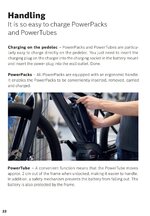PCeBiker
No-Hands No-Pedaling No-Credentials
- Region
- Canada
I don't care what the instructions say. Capacitors are nothing to mess with......
^^^ Yes
I would rather have that huge surge and spark at the wall socket rather than at the battery's charge port.
If you have a huge surge at the battery charge port, that surge is either going in or out of the rather delicate BMS circuit.
Keep in mind that the picture of that charger and instructions are most likely for a lead acid battery and that following the instructions means that the surge is done at the wall outlet so the capacitors are charged and the chargers output voltage is ~matched to the battery so there shouldn't be much of a spark or surge when the charger is connected to the battery.
The problem may well be that if the charger is connected to the battery before the wall plug, the capacitors in the charger may pull that charge/surge from the battery, but that's not too big a deal with a huge lead acid battery with no BMS, and a simple power diode (rated for more than the chargers rated output) will prevent reverse charging of the capacitors from the battery.
@Ravi Kempaiah
I want your take on this.
Perhaps chargers designed for lithium batteries are better designed to protect the battery and the BMS inside it, but most of the instructions go against what you say in your video.



